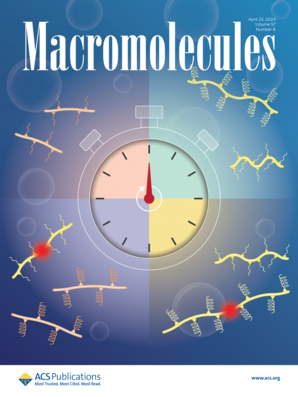用能量重整法建立的聚碳酸酯粗晶模型的力学响应表征
IF 5.1
1区 化学
Q1 POLYMER SCIENCE
引用次数: 0
摘要
聚碳酸酯(PC)在聚合物中具有独特的高韧性,使其非常适合用作抗冲击屏障材料。这种能量耗散倾向与骨干柔韧性、高纠缠密度和均匀性等特性有关。虽然最近的研究增强了我们对这些纳米级机制如何促进PC韧性的理解,但它们如何受到链的变形模式、速率和分子量的影响仍不清楚。为了在时空尺度上研究这些超出原子模型范围的影响,我们利用能量重整化方法建立了PC的粗粒度分子动力学(CGMD)模型。我们建立了屈服应力速率依赖关系遵循流动应力的Cowper-Symonds模型,该模型的拟合渐近收敛于与低速率实验数据一致的值。为了证明该模型的实用性,我们进一步探讨了PC链长度对断裂行为的影响,并表明通过扩大缠绕网络来提高材料的韧性,从而提高材料的应力水平。对于50个单体及以上的链,链长对屈服应力和弹性模量的影响最小,表明小应变力学响应主要由非键相互作用主导。这项工作可以增强对PC宏观力学行为的分子贡献的理解,并反映了聚碳酸酯链网络在调节能量耗散中的重要性。它还强调了在大应变下MD模型中键断的重要性。更广泛地说,它代表了pc基纳米复合材料的CGMD建模的关键一步。本文章由计算机程序翻译,如有差异,请以英文原文为准。

Characterizing the Mechanical Response of a Polycarbonate Coarse-Grained Model Developed with Energy Renormalization
Polycarbonate (PC) possesses uniquely high toughness among polymers, making it well-suited for use as an impact-resistant barrier material. This propensity toward energy dissipation has been associated with characteristics such as backbone flexibility, high entanglement density, and homogeneity. While recent works have enhanced our understanding of how these nanoscale mechanisms contribute to toughness in PC, it remains unclear how they are affected by the deformation mode, rate, and molecular weight of the chains. To study these effects over spatiotemporal scales that extend beyond the reach of atomistic models, we utilized a coarse-grained molecular dynamics (CGMD) model of PC developed with the energy renormalization method. We establish that yield stress rate dependence follows the Cowper–Symonds model for flow stress, the fit for which asymptotically converges to values consistent with low-rate experimental data. As a demonstration of the model’s utility, we additionally explore the effects of PC chain length on fracture behavior and show that toughness is improved through the augmentation of extensive entanglement networks that enable increased stress levels in the material. For chains 50 monomers and longer, chain length has a minimal effect on yield stress and elastic modulus, suggesting that small-strain mechanical response is dominated by nonbonded interactions. This work enables an enhanced understanding of molecular contributions to the macroscopic mechanical behavior of PC and reflects the importance of the polycarbonate chain network in modulating energy dissipation. It additionally highlights the importance of bond breaking in MD models subjected to large strain. More broadly, it represents a critical step toward the CGMD modeling of PC-based nanocomposites.
求助全文
通过发布文献求助,成功后即可免费获取论文全文。
去求助
来源期刊

Macromolecules
工程技术-高分子科学
CiteScore
9.30
自引率
16.40%
发文量
942
审稿时长
2 months
期刊介绍:
Macromolecules publishes original, fundamental, and impactful research on all aspects of polymer science. Topics of interest include synthesis (e.g., controlled polymerizations, polymerization catalysis, post polymerization modification, new monomer structures and polymer architectures, and polymerization mechanisms/kinetics analysis); phase behavior, thermodynamics, dynamic, and ordering/disordering phenomena (e.g., self-assembly, gelation, crystallization, solution/melt/solid-state characteristics); structure and properties (e.g., mechanical and rheological properties, surface/interfacial characteristics, electronic and transport properties); new state of the art characterization (e.g., spectroscopy, scattering, microscopy, rheology), simulation (e.g., Monte Carlo, molecular dynamics, multi-scale/coarse-grained modeling), and theoretical methods. Renewable/sustainable polymers, polymer networks, responsive polymers, electro-, magneto- and opto-active macromolecules, inorganic polymers, charge-transporting polymers (ion-containing, semiconducting, and conducting), nanostructured polymers, and polymer composites are also of interest. Typical papers published in Macromolecules showcase important and innovative concepts, experimental methods/observations, and theoretical/computational approaches that demonstrate a fundamental advance in the understanding of polymers.
 求助内容:
求助内容: 应助结果提醒方式:
应助结果提醒方式:


